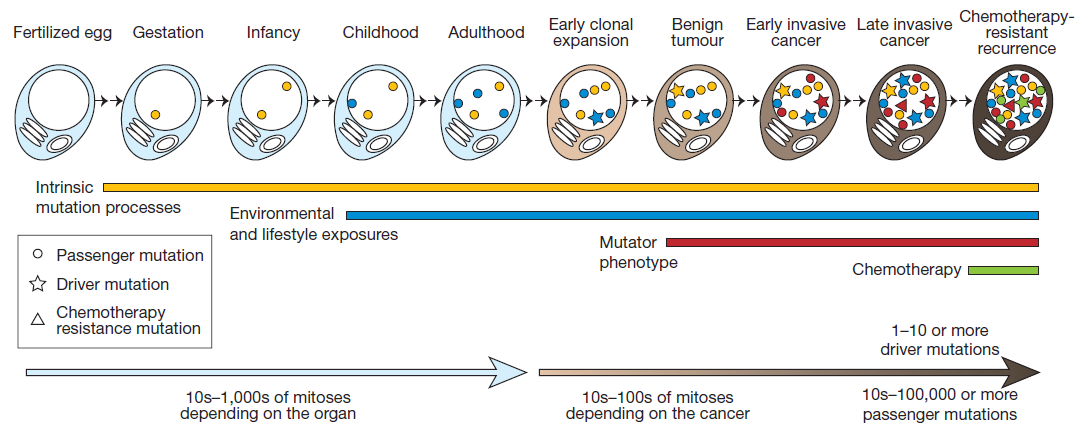 This picture shows the acquisition of mutations through the lifetime of a cell as it divides - from a single celled fertilized egg through to becoming a cancer cell. The lines and symbols show the timing of the somatic mutations acquired by the cancer cell and the processes that contribute to them, and are explained in detail in the text below.
This picture shows the acquisition of mutations through the lifetime of a cell as it divides - from a single celled fertilized egg through to becoming a cancer cell. The lines and symbols show the timing of the somatic mutations acquired by the cancer cell and the processes that contribute to them, and are explained in detail in the text below.
Only around 5% of cancers are due to constitutional mutations in single high-risk genes. The majority of cancers are caused by an accumulation of somatic mutations over the lifespan of an individual.
Imagine a single-cell fertilised egg. Over time, as a human develops from this fertilised egg into an embryo, a baby, a child and then an adult, hundreds of thousands of cell divisions (mitoses) will occur.
Each time a single cell divides, it must undergo replication of all 3 billion bases contained within the genetic code, followed by chromosome segregation and cell division.
The intrinsic machinery of the cell which controls DNA replication and cell division is not perfect, and every time a cell goes through this process, some errors will occur, introducing mutations into the DNA. This is represented by the yellow line above.
As we develop, we are also exposed to environmental and lifestyle factors, such as ultraviolet radiation from the sun, or cigarette smoking, which have the potential to induce mutations into our DNA. This is represented by the blue line above.
The mutations introduced into the DNA by these intrinsic and extrinsic processes can occur anywhere in the genome.
Most of the time, these mutations will not affect the ability of the cell to divide normally. But occasionally they will affect important genes which control cell division.
If a mutation causes a cell to lose control of the normal mechanisms regulating cell division, cell death or DNA repair, then uncontrolled, unstable, cell growth can occur, leading to tumour formation.
This type of mutation is known as a “driver” mutation because it “drives” tumour development. Driver mutations are represented by the stars in the cells above. The other mutations, which do not affect the ability of the cell to replicate normally, will also be passed down through the cell lineage alongside the “driver” mutations.
These are known as “passenger” mutations and are represented by the circles in the cells above.
Cells which have lost the ability to correctly regulate cell division due to driver mutations can accumulate new mutations rapidly as the cell loses the capacity to repair and regulate DNA replication and chromosome segregation, leading to a mutator phenotype represented by the red line above.
Cancer is the result of these abnormal cells, which grow uncontrollably and can invade other tissues. Chemotherapy may be given to kill the cancer cells. In some cases, mutations will occur which prevent the cell from dying in response to chemotherapy, leading to chemotherapy-resistant recurrence of cancer.
Source:- futurelearn.com
No comments:
Post a Comment